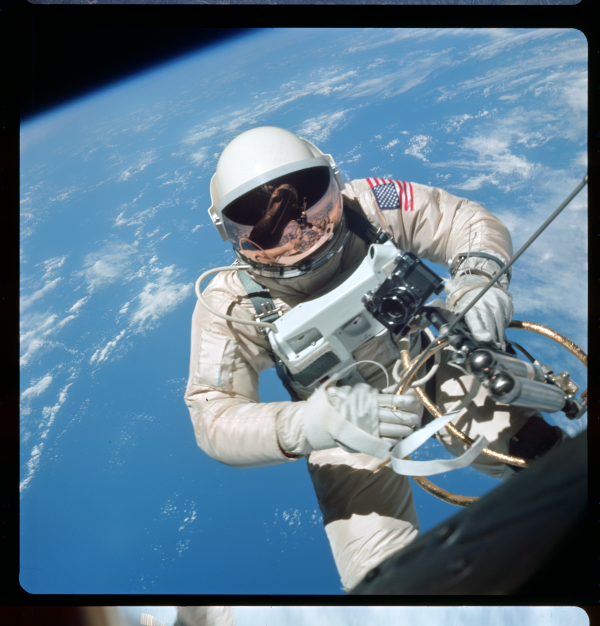An iconographic and text archive related to communication, technology and art.
☛ March To The Moon: photo from the Gemini IV mission depicting astronaut Edward White during NASA’s very first EVA (Extra Vehicular Activity), June 3, 1965, 19:45 GMT, shot with a Zeiss Planar 80mm lens mounted on a Hasselblad 500c 70 mm camera on Kodak Ektachrome film. Photo ID: S65-30431_G04-H. Flash is required to access some features. All photographs are in the public domain. Processed images (all except RAW) should be credited to NASA/JSC/Arizona State University.
Original captions read as follow:
Astronaut White floats in zero gravity of space northeast of Hawaii. White is attached to the spacecraft by a 25-ft. umbilical line and a 23-ft. tether line,both wrapped in gold tape to form one cord. In his right hand White carries a Hand-Held Self-Maneuvering Unit (HHSMU). The visor of his helmet is gold plated to protect him from the unfiltered rays of the sun.
This is one of 363 hi-res restored photographs related to the Gemini IV mission. Processed (enhanced) photographs for all Gemini missions were recently made available by NASA online. Each photographs is offered in three different resolution. The one I’m using is the smallest one: it’s a 553 kB 600×626 PNG file. One can also download a medium resolution (a 7MB 2205×2300 PNG file), a full resolution (a 28.1 MB 4410×4600 PNG file) or even an uncompressed RAW image (a huge 60.9 MB 4410×4600 TIFF file). Learn more about how the scans were made and how the original photographs were restored and enhanced.
The Gemini Program was the second human spaceflight program ran by NASA. It was preceded by the Mercury program (during which astronaut Alan Shepard became the very first American to orbit in space: see previously here “50 Years Ago: First American In Space”) and followed by the Apollo program (which ran from 1961 to 1972) and the Space Shuttle program (from 1981 to 2011).
An overview of the Gemini program is also available at the John F. Kennedy Space Center website:
The Gemini Program was conceived after it became evident to NASA officials that an intermediate step was required between Project Mercury and the Apollo Program. […]
The National Aeronautics and Space Administration announced December
7, 1961, a plan to extend the existing manned space flight program by development of a two-man spacecraft. The program was officially designated Gemini on January 3, 1962. It was named after the third constellation of the zodiac, featuring the twin stars Castor and Pollux. The program was operationally completed with the Gemini XII flight.
First spotted via WIRED.com
- By Philippe Theophanidis
- on
- ― Published in Communication, Photography, Technology
- Tagged: archive, astronaut, Gemini, Hasselblad, human spaceflight, man, NASA, space, vintage

